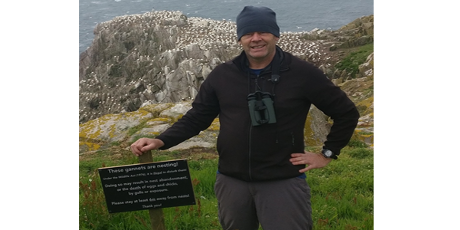Unwitting Tourists Cause Gannet Nests to Fail on Saltee 29 Oct 2020

Great Saltee Island in County Wexford is one of the most important seabird colonies in Ireland. It holds large numbers of seabirds and is an important tourist attraction. People can experience nature at its best and get close to some of our most spectacular species, including the largest seabird in Europe - the northern gannet.
However, as is true for many of our seabird colonies, Great Saltee does not have a warden, and many tourists unwittingly cause disturbance, leading to parents leaving their nests temporarily, exposing them to predators who quickly seize the opportunity and steal the gannets’ one and only egg.
Debs Allbrook, MSc student at UCC examined the level of disturbance caused by tourists in the summer of 2017. She showed that many tourists, especially those looking for that perfect photograph of birds on their nests, got too close to the gannets, often to within less than one metre. This led to a 60% reduction in breeding success compared with birds at undisturbed parts of the colony.
“On one occasion we saw nine disturbance events over a two-hour period. This directly led to eggs from 9 gannet nests being stolen by herring gulls, who seem to have learned to watch the interactions between tourists and people. One photographer ran right through the colony trying to retrieve his camera lens rolling downhill, leading to disturbance of about 30 nests.” said Professor John Quinn.
“Disturbance is not just distressing for the birds. This lack of management does a lot of damage to Ireland’s green-tourism reputation. We could see that some tourists were shocked by what they saw” added Professor Quinn.
As part of her research, Debs Allbrook then conducted a simple experiment to see if tourists would pay attention to an information sign warning them that their actions could be damaging. The sign said:
“These birds are breeding. Under the Wildlife Act (1976) it is illegal to disturb nesting birds. Please do not approach the colony as doing so may result in the abandonment of eggs or the death of chicks. Thank you for your consideration.”
Remarkably, the vast majority of people paid attention to the sign. People stayed away from the birds and fewer disturbance events were observed.
“This showed that it was largely lack of knowledge that led to the disturbance in the first place. People did not understand the harm they were causing. When approaching a bird on a nest like that, because they seem fairly unfazed, people believe they are fine to go right up to them. We showed that in fact these 'harmless' encounters could have much more serious effects than we thought. The disturbance often caused confusion in the colony and it only took a second for a gull to zip in and steal an egg" said Debs Allbrook.
For such a basic management tool, studies that show the effectiveness of signage like this are surprisingly rare worldwide, and have never been conducted in Ireland previously.
“It was especially good to know whether these signs would work in the absence of any warden on the island, and they did. Perhaps the presence of other tourists helped to ensure that everyone obeyed the sign”, said Debs Allbrook.
Covid stopped large numbers of tourists going to Great Saltee in 2020. Unofficial reports indicate that areas where large numbers of gannets had failed to breed from disturbance, in fact had successful breeding, probably for the first time in years. The other good news is that gannet numbers are increasing, despite the disturbance, for reasons that are not fully understood.
The full publication can be accessed now online here: https://doi.org/10.1016/j.jnc.2020.125915
Press Contact: Prof John Quinn, UCC Ornithology Group on 0852266122
Photos credit: Tom Mason
Photo: Prof John Quinn with permanent sign